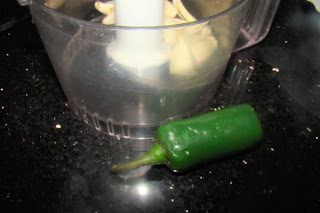
I am posting this recipe for Indian Sabudana Vada which is usually made in India by adding potatoes and spices and is deep fried. I made it here with adding shelled edamame to add some protein to this dish. I had tried the deep fried version of this recipe but it just soaked too much oil and I decided not to post that version. This time I decided to make these in Air fryer. They came out perfect minus all that oil. However let me give you some information on Sago or Sabudana.
 Sago is a starch extracted from the spongy center, or pith, of various tropical palm stems, especially those of Metroxylon sagu. It is a major staple for the lowland peoples of New Guinea and Moluccas , where it is called saksak, rabia and sagu.
The largest supply of sago comes from Southeast Asia, particularly
Indonesia and Malaysia. Large quantities of sago are sent to Europe, and North America for cooking purposes. It is traditionally cooked and eaten in various forms, such as rolled
into balls, mixed with boiling water to form a glue-like paste papeda or as a pancake. Sago is often produced commercially in the form of "pearls" (small rounded starch aggregates, partly gelatinized by heating). Sago pearls can be boiled with water or milk and sugar to make a sweet sago pudding. Sago pearls are similar in appearance to the pearled starches of other origin, e.g.Cassave starch (tapioca) and potato starch, and they may be used interchangeably in some dishes.
Sago is a starch extracted from the spongy center, or pith, of various tropical palm stems, especially those of Metroxylon sagu. It is a major staple for the lowland peoples of New Guinea and Moluccas , where it is called saksak, rabia and sagu.
The largest supply of sago comes from Southeast Asia, particularly
Indonesia and Malaysia. Large quantities of sago are sent to Europe, and North America for cooking purposes. It is traditionally cooked and eaten in various forms, such as rolled
into balls, mixed with boiling water to form a glue-like paste papeda or as a pancake. Sago is often produced commercially in the form of "pearls" (small rounded starch aggregates, partly gelatinized by heating). Sago pearls can be boiled with water or milk and sugar to make a sweet sago pudding. Sago pearls are similar in appearance to the pearled starches of other origin, e.g.Cassave starch (tapioca) and potato starch, and they may be used interchangeably in some dishes.
 The name sago is also sometimes used for starch extracted from other sources, especially the sago cycad, Cycas revoluta. The sago cycad is also commonly known (confusingly) as the sago palm, although this is a misnomer as cycads are not palms. Extracting edible starch from the sago cycad requires special care due to the poisonous nature of cycads Cycad sago is used for many of the same purposes as palm sago.
The name sago is also sometimes used for starch extracted from other sources, especially the sago cycad, Cycas revoluta. The sago cycad is also commonly known (confusingly) as the sago palm, although this is a misnomer as cycads are not palms. Extracting edible starch from the sago cycad requires special care due to the poisonous nature of cycads Cycad sago is used for many of the same purposes as palm sago.
 The fruitt
of palm trees from which the sago is produced is not allowed to ripen
fully. The full ripening completes the life cycle of the tree and
exhausts the starch reserves in the trunk to produce the seeds. It
leaves a hollow shell and causes the tree to die. The palms are cut down
when they are about 15 years old, just before or shortly after the inflorescence appears. The stems, which grow 10 to 15 meters high, are split out. The starch-containing pith is taken from the stems and ground to powder. The powder is kneaded in water over a cloth or sieve
to release the starch. The water with the starch passes into a trough
where the starch settles. After a few washings, the starch is ready to
be used in cooking. A single palm yields about 360 kilograms (800 lb) of
dry starch.
The fruitt
of palm trees from which the sago is produced is not allowed to ripen
fully. The full ripening completes the life cycle of the tree and
exhausts the starch reserves in the trunk to produce the seeds. It
leaves a hollow shell and causes the tree to die. The palms are cut down
when they are about 15 years old, just before or shortly after the inflorescence appears. The stems, which grow 10 to 15 meters high, are split out. The starch-containing pith is taken from the stems and ground to powder. The powder is kneaded in water over a cloth or sieve
to release the starch. The water with the starch passes into a trough
where the starch settles. After a few washings, the starch is ready to
be used in cooking. A single palm yields about 360 kilograms (800 lb) of
dry starch.

In Brazil, sago is extracted from cassava root, in what is known in English as tapioca. It is usually mixed with sugar and red wine and then served as a pudding dessert called sagu de vinho (wine sago), popular in the southern state of Rio Grande do su. When soaked and cooked, both become much larger, translucent, soft and spongy. Both are widely used in Indian, Bangladeshi and Sri Lankan cuisine in a variety of dishes and around the world, usually in puddings. In India, it is used in a variety of dishes such as desserts boiled with sweetened milk on occasion of religious fasts. In India, "Tapioca Sago" is considered an acceptable form of nutrition during periods of fasts for religious purposes or for infants or ill persons. In the UK, both sago and tapioca have long been used in sweet milk puddings.
In New Zealand, sago is boiled with water and lemon juice and sweetened with golden syrup to make lemon sago pudding.
In India, Tapioca Sago is used mainly to make the food items like "Kheer","Khichadi", "Vada" etc.
 Sago from Metroxylon palms is nearly pure carbohydrate and has
very little protein, vitamins, or minerals. 100 grams of dry sago
typically comprises 94 grams of carbohydrate, 0.2 grams of protein,
0.5 grams of dietary fiber, 10 mg of calcium, 1.2 mg of iron and
negligible amounts of fat, carotene, thiamine and ascorbic acid and
yields approximately 1,490 kilo-joules (355 kcal).
Sago from Metroxylon palms is nearly pure carbohydrate and has
very little protein, vitamins, or minerals. 100 grams of dry sago
typically comprises 94 grams of carbohydrate, 0.2 grams of protein,
0.5 grams of dietary fiber, 10 mg of calcium, 1.2 mg of iron and
negligible amounts of fat, carotene, thiamine and ascorbic acid and
yields approximately 1,490 kilo-joules (355 kcal).Ingredients:
- 2 cups of Sago pearls (Sabudana)
- 4 medium potatoes
- 2 cups of shelled edamame (16 oz bag)
- 1 bunch of fresh Cilantro
- 5 spring onions with greens
- 6 cloves of garlic
- 1/2 cup of unsalted roasted peanuts
- 1-2 fresh Jalapeno peppers
- Water to soak Sabudana
Spices:
- Salt to taste
- 2 tablespoon of powdered roasted cumin seeds
- 1 tablespoon of powdered cayenne pepper
- 1 teaspoon of coarsely ground black pepper
- 2 tablespoon of mango powder
- 1 teaspoon of garam masala (all spice) optional
- Juice for 1 fresh lime
- Cooking oil spray
Method:
- Wash Sago pearls thoroughly.
- Soak them in water for one hour.
- Drain all the water out and let some water remain in base of the bowl and let it sit covered for 3-4 hours.
- Boil and peel potatoes
- Finely chop all the greens and garlic cloves
- I bought shelled edamame in 16 oz frozen bag which you can microwave for 5-6 min in bag, prep it this way and let them cool.
- Coarsely grind the roasted peanuts in food processor, empty in bowl and set aside.
- In the same food processor finely grind the cooled edamame.
- Add cilantro to this and turn the food processor until the cilantro is chopped.
- Drain the remaining water from soaked sago pearls. They should be soft by now.
- Add ground peanuts and ground edamame.
- Add all the spices, lime juice, and mash potatoes in the sago pearl with all the spices.
- Mash until the potatoes are not lumpy.
- You can mash potatoes separately and add this to the mixture.
- Mix everything well until everything is well incorporated.

- Preheat the air fryer at 400 degrees.
- Line the try with parchment paper, spray with cooking oil.
- Place the flattened ball on the parchment paper lined tray.
- Spray the top of balls with cooking oil.
- Air fry for 10 min on one side then carefully flip to other side and air fry for 10 additional minutes.
- I have Cuisinart air fryer, which is the best.
- You can see through the glass door and light is on when the door is closed and it is on.
- When you open the the door the air fryer shuts off which gives you time to flip the content safely.
- Repeat the process until all the balls are air fried.
- Serve hot with mint cilantro chutney or any of your favourite sauces.
- This recipe yields small 40 vadas.
- You can cut the recipe in to half to make 20.
- These freeze well too.
Enjoy !!
https://en.wikipedia.org/wiki/Wikipedia:Text_of_Creative_Commons_Attribution-ShareAlike_3.0_Unported_License
Recipe and Photographs by Surekha.

























































